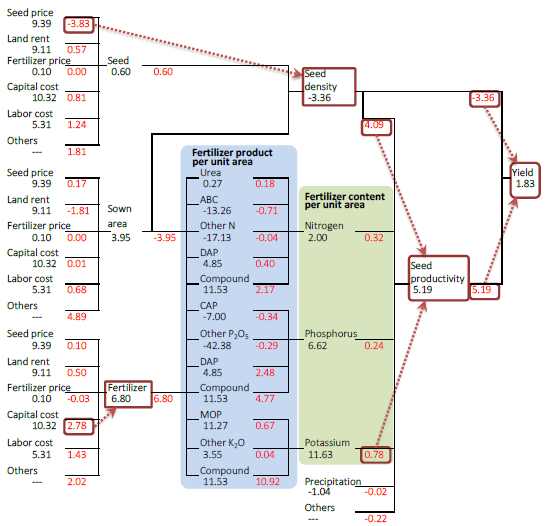Decomposition analysis of maize yield change in China
Description
China, the world’s second largest producer and consumer of maize, has been a net importer since 2010. On the other hand, maize production nearly doubled during the period 2000–2012, with a 28% increase in yield per harvested area. Accordingly, this study examined the effects of prices and quantities of agricultural inputs as well as climatic factors on maize yield in China.
Maize yield was decomposed using results from factor demand functions and from a crop response model. The results show that the annual yield rate change (1.8%) is decomposed to the decrease in seed density (–3.4%) and the increase in seed productivity (5.2%) (Fig. 1). Values of the direct effect (–3.4%) and indirect effect through seed productivity (4.1%) of the seed density imply negative correlation between seed density and yield. Seed density decreases with the rise in seed price (–3.8%), and this effect seems larger than those of other prices. When comparing the contribution of fertilizer content to seed productivity, the value of potassium (0.8%) is higher than the others. The rapid increase in fertilizer input (6.8%) is parallel with the higher cost of capital (2.8%). The result of regional analysis revealed that the yield decreases with lower seed density in several regions where seed density is lower than the average (Fig. 2). The contribution of land rent to feed density and fertilizer per area is higher in the Northeast and North China Plains, which are major maize producing areas. On the other hand, the contribution of capital, agricultural machines, and draught animals seems higher in the southern regions.
This study clarified the effects of each price and quantity of input goods on the maize yield. The result can help promote discussion on the effects of policies to increase maize yield in China. Furthermore, the results can bind macro-level individual studies on yield, economic factors, and agricultural input goods. However, there are several limitations. This study did not analyze the effects of disseminating higher yielding seeds and of improving production circumstances on the decreasing seed density. The effects of nutrient balance should also be analyzed in more detail.
Figure, table
-
Fig. 1. Effects of factors influencing change in maize yield, China (2004–2012) The number below each item is the annual average rate of change (%). The numbers below the lines are the contributions of the left-hand items to the right-hand items, in percentage points. Values are calculated from data of 18 provincial-level divisions.
-
Fig. 2. Annual average rate of change of factors composing each item (in percentage points, 2004–2012 data)
- Affiliation
-
Japan International Research Center for Agricultural Sciences Research Strategy Office
Japan International Research Center for Agricultural Sciences Social Sciences Division
- Classification
-
Administration B
- Research project
- Program name
- Term of research
-
FY 2014 (FY 2013-FY 2015)
- Responsible researcher
-
Kusano Eiichi ( Social Sciences Division )
Hsiaoping Chien ( Social Sciences Division )
Yongfu Chen ( China Agricultral University )
Koyama Osamu ( Research Strategy Office )
- ほか
- Publication, etc.
-
Kusano et al. (2015) Effect of input prices on maize yield in China, Journal of agricultural development studies, 26 (1)
- Japanese PDF
-
2014_C03_A3_ja.pdf1.51 MB
2014_C03_A4_ja.pdf1.67 MB
- English PDF
-
2014_C03_A3_en.pdf1.39 MB
2014_C03_A4_en.pdf1.54 MB
- Poster PDF
-
2014_C03_poster.pdf677.21 KB


